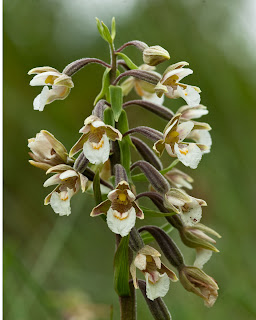The plan was simple-hit Norfolk, pick up a few good birds and hopefully some insects and orchids too.
Titchwell has had a long staying adult Buff Breasted Sandpiper so it seemed a good place to start-before the heat haze got going, and also because it was the last weekend before they shut the main path.
Tide looked favourable, with lots of loafing gulls and waders to pick through. Large numbers of Ruff including some of the smaller Buff Breast lookalike females seemed to be the big problem, but it turned out to be a different wader that would cause most discussion. Small (ish) with a plain, fine, not at all 'scaly' feathering and a prominent pectoral band, realisation took a long time to sink in-only confirmed when another 100 or so similar Knot flew in. Bit out of practice.
Lots of Godwits, Avocet Oystercatcher and Redshanks of course, one Snipe and a few Green Sands. The gulls were not exciting, just Black Heads and a few Common and Herring.
No sign of the Buff Breast at all-we assumed it was hiding in the vegetation because of the rather strong offshore wind.
The sea was pretty dead of course, thanks to that wind, a few moulting Eider, three or four Little Tern, the occasional Sandwich and someone had a Gannet as well.
Not much happening on the Fen pools either, just a few Common Darters and Blue Tailed Damsels.
We decided to go down and visit the 'secret' Montague's Harrier watchpoint that virtually everyone knows about. The RSPB signs and the warden sitting in the deckchair are useful clues.
Before we even got there, a slender rakish harrier flew over the car.
MONTY'S!
We managed to pull over and I got a few shots . Unfortunately when I got the images up on my computer, the lack of a white rump was a problem, so I counted the primaries-five. Damn. A fuzzy shot showed the dark brown body and cream head of a juvenile Marsh. One of those days I guess.
Still, we arrived at the watchpoint to hear that a female had been seen to the north, but had gone down. The vast flock of feeding Swifts proved entertaining, obviously feeding up over the fields before their departure in a couple of weeks. Lots of juveniles of course.
After about forty minutes and still thinking we had seen a Montague's we drove off, heading south west and after a mile or so an obvious ring tail flew over the car. Bit lucky there.
With Marsh Helleborine in flower on the coastal dunes, I had planned to visit Holme, or Holkham, but we headed off to Narborough Railway line instead. Did not take long to find several hundred spikes in the southern hollow.
Plenty of butterflies too, Gatekeeper, Ringlet, Green Vein, Large and Small Whites, lots of Small and Essex Skippers, a few Comma's and Brimstone. Even one Small Copper and a Brown Argus. and there
were a few Common Darters and Brown Hawkers too.

Unfortunately the heat and humidity was building up to uncomfortable levels so we went back up to the old railway line to catch the breeze. Pyramidal Orchids were still fresh, and much of the special chalk flora looked wonderful. I spent some time in a sheltered area with the Harebells.
With time getting on we headed home, and called in at Deadman's Hill on the way. A quick scan revealed a large raptor but when I got the scope out, all I could see was a Kestrel. However not long after, a female Marsh Harrier popped up over the eastern ridge and then a Buzzard came up and mobbed it, before both dropped down again. Shortly after that excitement, I heard at least one Quail calling along the footpath in a filed of low Flax. I was able to get a lot closer, but despite the bird being no more than thirty feet away it never showed. In all probability a second, more distant bird may have been calling as well.





No comments:
Post a Comment